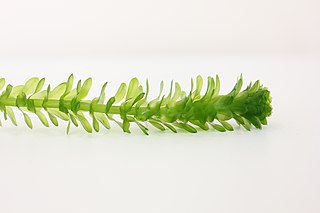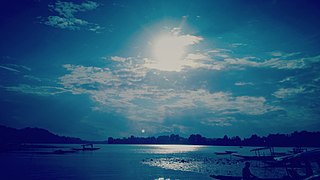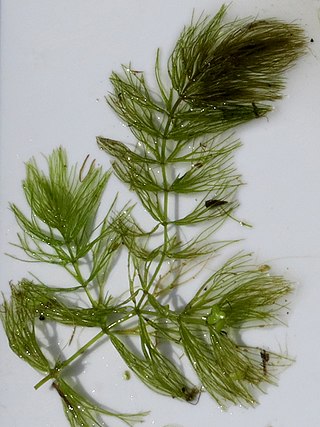
Aquatic plants are plants that have adapted to living in aquatic environments. They are also referred to as hydrophytes or macrophytes to distinguish them from algae and other microphytes. A macrophyte is a plant that grows in or near water and is either emergent, submergent, or floating. In lakes and rivers, macrophytes provide cover for fish, substrate for aquatic invertebrates, produce oxygen, and act as food for some fish and wildlife.

Ceratophyllum is a cosmopolitan genus of flowering plants including four accepted living species in 2016, commonly found in ponds, marshes, and quiet streams in tropical and in temperate regions. It is the only extant genus in the family Ceratophyllaceae, itself the only extant family in the order Ceratophyllales. They are usually called coontails or hornworts, although hornwort is also used for unrelated plants of the division Anthocerotophyta.

Ceratophyllaceae is a cosmopolitan family of flowering plants including one living genus commonly found in ponds, marshes, and quiet streams in tropical and in temperate regions. It is the only extant family in the order Ceratophyllales. Species are commonly called coontails or hornworts, although hornwort is also used for unrelated plants of the division Anthocerotophyta.

Lake Okeechobee is the largest freshwater lake in the U.S. state of Florida. It is the tenth-largest natural freshwater lake among the 50 states of the United States and the second-largest natural freshwater lake contained entirely within the contiguous 48 states, after Lake Michigan.

Hydrilla (waterthyme) is a genus of aquatic plant, usually treated as containing just one species, Hydrilla verticillata, though some botanists divide it into several species. It is native to the cool and warm waters of the Old World in Asia, Africa and Australia, with a sparse, scattered distribution; in Australia from Northern Territory, Queensland, and New South Wales.
This article gives an overview of the aquatic communities in the British National Vegetation Classification system.

The North Somerset Levels is a coastal plain, an expanse of low-lying flat ground, which occupies an area between Weston-super-Mare and Bristol in North Somerset, England. The River Banwell, River Kenn, River Yeo and Land Yeo are the three principal rivers draining the area.

A lake ecosystem or lacustrine ecosystem includes biotic (living) plants, animals and micro-organisms, as well as abiotic (non-living) physical and chemical interactions. Lake ecosystems are a prime example of lentic ecosystems, which include ponds, lakes and wetlands, and much of this article applies to lentic ecosystems in general. Lentic ecosystems can be compared with lotic ecosystems, which involve flowing terrestrial waters such as rivers and streams. Together, these two ecosystems are examples of freshwater ecosystems.

Ceratophyllum demersum, commonly known as hornwort, rigid hornwort, coontail, or coon's tail, is a species of flowering plant in the genus Ceratophyllum. It is a submerged, free-floating aquatic plant, with a cosmopolitan distribution, native to all continents except Antarctica. It is a harmful weed introduced in New Zealand. It is also a popular aquarium plant. Its genome has been sequenced to study angiosperm evolution.

Egeria densa, the large-flowered waterweed or Brazilian waterweed, is a species of Egeria native to warm temperate South America in southeastern Brazil, Argentina, Chile and Uruguay. It is considered a problematic invasive species due to its use in home aquariums and subsequent release into non-native ecosystems.

Lake Orestiada or Lake of Kastoria is a lake in the Kastoria regional unit of Macedonia, northwestern Greece. It spreads out in a natural basin, surrounded by mountains and is the remnant of a huge ancient Miocene lake that reached an area of 164 square kilometres and at a depth of 50 meters. Sitting at an altitude of 630 metres, the lake covers an area of 28 square kilometres with a coastline that reaches 34 km. The maximum depth of the lake reaches about 9 meters and the average depth 4.5 meters.

Potamogeton perfoliatus is a perennial aquatic plant in the family Potamogetonaceae occurring in both standing and flowing freshwater habitats. It is widely distributed globally, occurring in all continents except South America and Antarctica.

Manasbal Lake is a freshwater lake located in Safapora area of Ganderbal District in Jammu and Kashmir, India. The name Manasbal is said to be a derivative of Manasarovar. The lake is encircled by four villages viz., Jarokbal, Kondabal, Nesbal and Gratbal. The large growth of lotus at the periphery of the lake adds to the beauty of the clear waters of the lake. The Mughal garden, called the Jaroka Bagh, built by Nur Jahan overlooks the lake.

Hygraula nitens, the pond moth or Australian water moth, is a moth of the family Crambidae. It was described by Arthur Gardiner Butler in 1880. It is found in New Zealand and most of Australia, including Tasmania.

Potamogeton lucens, or shining pondweed, is an aquatic perennial plant native to Eurasia and North Africa. It grows in relatively deep, still or slow-flowing, calcareous freshwater habitats.

Potamogeton gramineus is a species of aquatic plant known by the common name various-leaved pondweed, variableleaf pondweed, grass-leaved pondweed or grassy pondweed, native to the northern hemisphere where it grows in shallow, clean water.

Ceratophyllum echinatum, known as prickly hornwort, spiny hornwort, or spiny coontail, is an aquatic, perennial plant found in North America. Its name comes from fruits, which have a warty surface and long spines. Spiny hornwort can be found in ponds and lakes, principally in eastern North America. It is the only species of its genus endemic to North America.

Podostemum ceratophyllum, commonly known as the hornleaf riverweed, is a species of submerged aquatic plant in the family Podostemaceae. It is native to eastern North America where it grows on hard bottoms in swiftly flowing rivers and streams and is considered a foundation species.
The anthophytes are a grouping of plant taxa bearing flower-like reproductive structures. They were formerly thought to be a clade comprising plants bearing flower-like structures. The group contained the angiosperms - the extant flowering plants, such as roses and grasses - as well as the Gnetales and the extinct Bennettitales.

Xiphophorus pygmaeus, the pygmy swordtail, is a poeciliid fish from northeastern Mexico. It is the smallest of the swordtails. The male's sword is barely visible and the species is often called the swordless swordtail. It is sometimes kept in home aquaria, but is a rather delicate species.




















